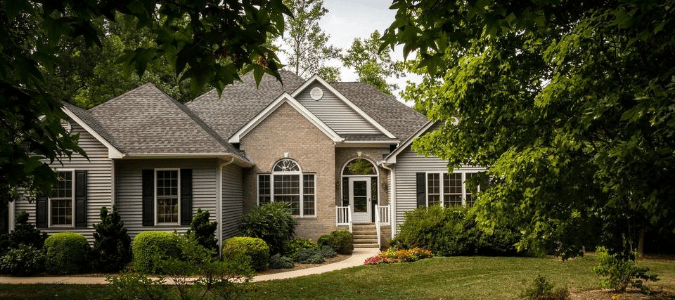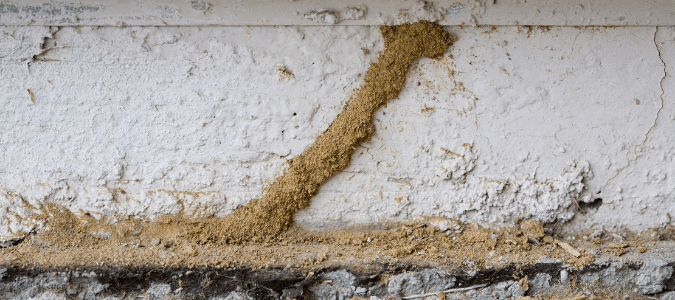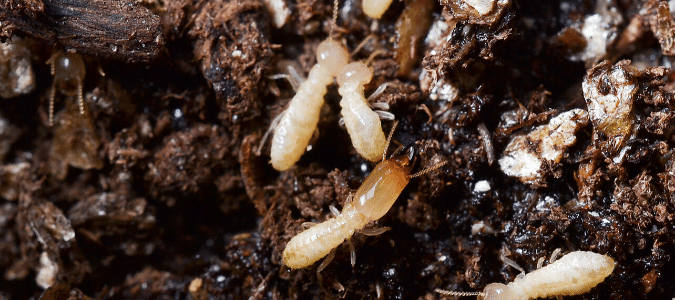If you’re dealing with a termite infestation or if you think you may be dealing with a termite infestation, you may be overwhelmed and confused. How did termites find your home? How did they make their way inside? What can you do next?
To answer these questions, it’s important to know the different types of termites that are likely to infest your home. In the U.S., the two most common types of termites are subterranean termites and drywood termites. Knowing the differences between these two types is important because the way they enter homes and the treatment methods for each are different.
Subterranean Termites
Subterranean termites travel around by crawling through a network of underground tunnels. This species of termite needs a moist environment to survive. Once they get beneath or to the edge of a house, they build mud tubes, which they use to get into the structure. These tubes are about the same thickness as a pencil and they’re made from materials like soil and bits of wood.
These pests look for cracks in the foundation, gaps around pipes and other openings on the outside of the structure. The termites then use these tunnels to enter the home, move around and access parts of the home that are edible. They might also build tubes from the ground up through a crack in a crawl space. These freestanding tunnels are also called drop tubes.
Subterranean termites can take advantage of even the smallest opening. Some of the places that are most vulnerable to this type of termite are gaps along the foundation. These spots are especially susceptible to termites when there is something built next to the foundation, like a porch or a pergola. These pests can also enter the home through bath traps, expansion joints or siding that partially extends into the soil.
Drywood Termites
Drywood termites do not build mud tubes. They can survive off the moisture they find in wood, so they do not need moist tunnels to travel through like subterranean termites. Instead, they fly to the wood they feed on, which means they can enter your home through a crack at any level of the structure.
Drywood termites might get into your house through a gap along a door frame, crack in your roofing or an unscreened vent or window. These pests can also enter your home through items you bring inside. For this reason, it can be beneficial to check and make sure furniture and other wooden items aren’t infested before you bring them into your house.
Signs Of An Infestation
One of the most common signs that you might have a termite infestation is if you see damaged wood. This could indicate that either you currently have termites in your home or that you had a termite problem in the past. It’s hard to know for sure if wood is damaged without opening it up. However, one thing you can do to check whether your wall, table or another wooden item might be damaged is to lightly tap it with a hammer. If you hear a dull or hollow sound, then the wood might have damage.
Another sign you can look out for is mud tubes, which can indicate subterranean termites are present. These pests build most of their tunnels inside soil, sheetrock, walls, the foundation and other areas of a structure. You’ll likely see signs of mud tubes instead of the tunnels themselves.
Signs of these tubes can include bubbling or uneven paint on a wall. However, some of the external areas where you might find these tubes include cracks in the wall, hanging in your crawl space or between boards. If you find what might be a mud tube, look to see if there are piles of termite feces, which resembles sawdust. If you spot one of these piles, it’s a likely sign of infestation.
You can also look for bodies of dead termites or termite parts like wings, which could indicate a termite infestation. Some of the best places to look for these signs include in spider webs, along window sills or inside light canisters. Flying termites—also called swarmers—shed their wings when a termite colony has reached maturity. Swarmers leave the nest to find a mate and start a new colony. If you find termite wings in your house, then you’re likely dealing with an established termite colony.
If you suspect you might have a termite infestation, it’s wise to act quickly to keep the problem from getting worse. Once termites get inside your house, they can build additional colonies within your home and attack several different parts of the structure. For example, subterranean termites usually need to return to soil in order to reproduce and grow their colonies. However, if they find a moist place in your house, such as the area around a plumbing leak, they can use this area as their new home, multiply within your house and feed off any of the wood in your home.
The best way to handle a possible termite infestation is to contact a termite control specialist. It’s often difficult for homeowners to determine the extent of a termite infestation on their own and know the best ways to get rid of these pests. That’s why government agencies and other experts recommend enlisting the help of professionals. They have the tools and training necessary to tackle these types of pest problems. They can also confirm you have termites and not something else.
Is It a Mud Dauber Nest or Termites?
Subterranean termites aren’t the only kind of pest that uses tubes that look like mud. For example, mud dauber wasps also build a series of tubes that they use as nests. The tubes that these different kinds of pests build look similar, but they have some features that can help you tell whether you’re looking at a termite’s mud tube or a mud dauber’s nest.
For one, mud daubers usually construct a series of tubes side-by-side. Most of the time, these tubes are only about one inch long and they’re made of mud. The wasps typically build these nests in sheltered areas, such as in sheds, under eaves or along porch ceilings.
On the other hand, termites usually build longer tubes that are separate from one another instead of stacked side-by-side, as you can see in the image above. These tubes are most often found inside walls and other wooden structures. When termites’ mud tubes are on the outside of a home, they are more likely to be along the foundation, on an exterior wall or squeezed inside a crack than in a sheltered area like mud dauber nests. Termites make these tubes out of materials like wood pieces, and the tubes can extend for several feet.
If you find what you think might be a termite mud tube, it is often best to contact a professional instead of trying to identify it yourself. Determining what kind of infestation you have can be dangerous because mud daubers can sting. However, a trained professional can help protect you and your family by taking care of all your pest control needs for you.
These pros can determine what kind of pests you might have around your home. They can also work with you to set up a plan to tackle the current infestation and help prevent pest infestations in the future.
Where are Termites Found?
Almost every state in the U.S. has some type of termites. While some termites thrive in moist and tropical areas, other species can live in a range of climates. Termites can be found in all types of habitats, such as underground, in dense vegetation, in dead trees, in wooden structures and in the tops of live trees.
Some of the different species of termites that are found in the United States include:
- Dampwood termites. This type of termite only infests wood that is very moist. They are most commonly found in cool and humid areas, such as in mangrove forests. It’s very unlikely that these pests would invade your property.
- Subterranean termites. This type of termite shows up in almost all areas of the U.S., and it’s the species that causes much of the damage that homeowners experience. They typically travel underground or inside structures because they need moisture to survive.
- Drywood termites. These pests feed on dry wood like dead trees, decks, lumber, utility poles and wooden structures. They can be found everywhere from moist coastal areas to drier desert regions. Drywood termites travel aboveground and do not need moist soil to get around.
Moist, tropical climates make some areas of the U.S. more susceptible to termite problems than other areas of the country. However, because termites can easily be transported through timber, mulch or other vegetation, homeowners in almost any place in the U.S. could experience a termite infestation. If you think termites are present on your property, it is important to contact pest control professionals.
Termite control specialists have the tools, training and equipment needed to thoroughly inspect your property, figure out whether you have an infestation and treat the pests. These pros can help take care of your pest problem before it gets worse, plus they can help reduce the chance of termites coming back to your property.
ABC Can Treat and Prevent Termites
Termites are responsible for costing homeowners across the U.S. billions of dollars in property damage. If you believe you may have termites on your property, contact ABC Home & Commercial Services. We use scientifically proven methods to eliminate these pests, so you can have peace of mind.



